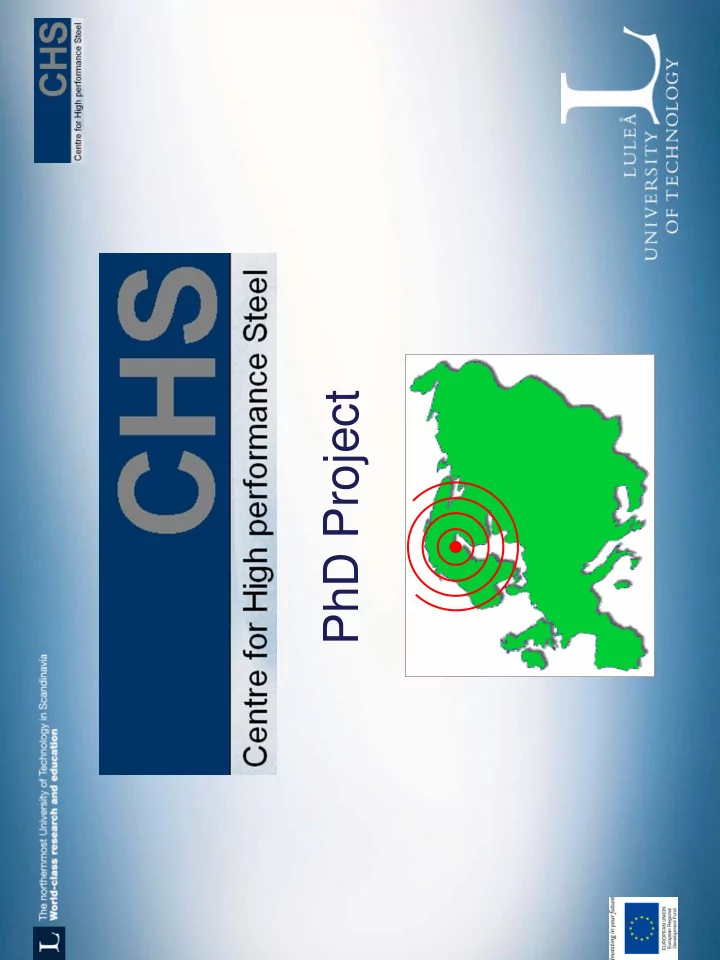

PhD Project
PhD Project Wear and fatigue properties of novel nanostructured bainitic steel grades for high performance components PhD student: Alejandro Leiro Main Supervisors: Braham Prakash, Karl-Gustaf Sundin Associate Supervisor: Esa Vuorinen
Outline Background Aim and Scope of work R&D plan 2009-2011 Ongoing research activities Results and Publications
Background What is a Nanobainitic or ausferritic Steel? Developed by HK. Bhadheshia and co-workers Theoretically created grades Austempering at low Temperature Extremely fine Microstructure Taken from: F.G. Caballero et al. / Materials and Design 30 (2009) Si content ~1,5% 2077–2083 Carbide free Outstanding Mechanical properties
Background Why are they Interesting? Small amount of alloying elements Austempering treatment done at low temperatures (200-300 Celsius Allows bigger sections than Q&T steels Very cheap steels Outstanding mechanical properties UTS in the range of 1600–1700 MPa. Toughness values of 130 MPa m 1/2 Show promise in industrial applications
Background Research Gaps A lot of attention has been directed towards the alloying of these steels. Bhadeshia, Caballero, Putatunda. Typical mechanical properties (UTS, YS, Charpy, etc.) have been studied More complex properties (Fatigue, Wear, etc.) are yet to be evaluated
Aim and Scope of Work Wear behaviour of ausferritic steels Rolling-Sliding Pure sliding Wear in corrosive environments Understanding the wear mechanisms Fatigue Properties Standing contact fatigue Rotating bending Fretting? Correlating properties to Microstructure Austenite content Grain/lath size
R&D Plan 2009 Wear properties and behavior of bainitic and commercial steels (reference group) Wear properties and behavior of ausferritic steels with different carbon contents (extended to 2010) 2010 Standing contact fatigue evaluation of nanobainitic steels Pure sliding behaviour of ausferritic steels Rotating-Bending fatigue evaluation of nanobainitic steels 2011 Fretting behavior Wear in corrosive environments
Ongoing Research Activities Metalography and hardness measurements Quantitative XRD analysis Austenite content Carbon content in the austenite and ferrite SEM and EDS Microstructure characterization Wear mechanism identification Rolling-sliding behaviour of ausferritic steels Standing contact fatigue properties of ausferritic steels
Results Frictional Behaviour The higher hardness of the Ausferritic steel prevents the oxidized wear debris from being crushed into the surface, providing a more stable frictional behaviour over time ~0,18 ~0,08 Conventional Bainitic steel New Ausferritic Carbide free steel
Results Wear Resistance Ausferritic Steels with carbon contents of 0,8% and 1% seem to perform better unde rolling-sliding conditions than conventional steels and 60CrSi with an ausferritic microstructure 6,00E ‐ 04 Test 2 Test 1 5,00E ‐ 04 Specific Wear Rate (mm3/N.m) Austempering Temperature 4,00E ‐ 04 300 °C 3,00E ‐ 04 Austempering Austempering Temperature Temperature 250 °C 2,00E ‐ 04 250 °C 1,00E ‐ 04 0,00E+00 0,8C 1C Bainitic Pearlitic 60SiCr7 60SiCr7 Specific wear rates of different steels tested under the same conditions
Results and Publications 2009 So far ausferritic steels seem to outperform the conventional steels that they have been compared against, as well as other ausferritic steels 2010 Fatigue and further wear behaviour studies will provide more information about the potential of these steels in industrial applications A contribution to the NordTrib Conference on the wear behaviour of ausferritic micro-structures has been reviewed and accepted by the comitee Fatigue studies are planned for the 2nd half of 2010 2011 The fretting and corrosion behavior under rolling sliding or pure sliding contacts will give the more complex properties of these materials and will complement the previous studies
Recommend
More recommend